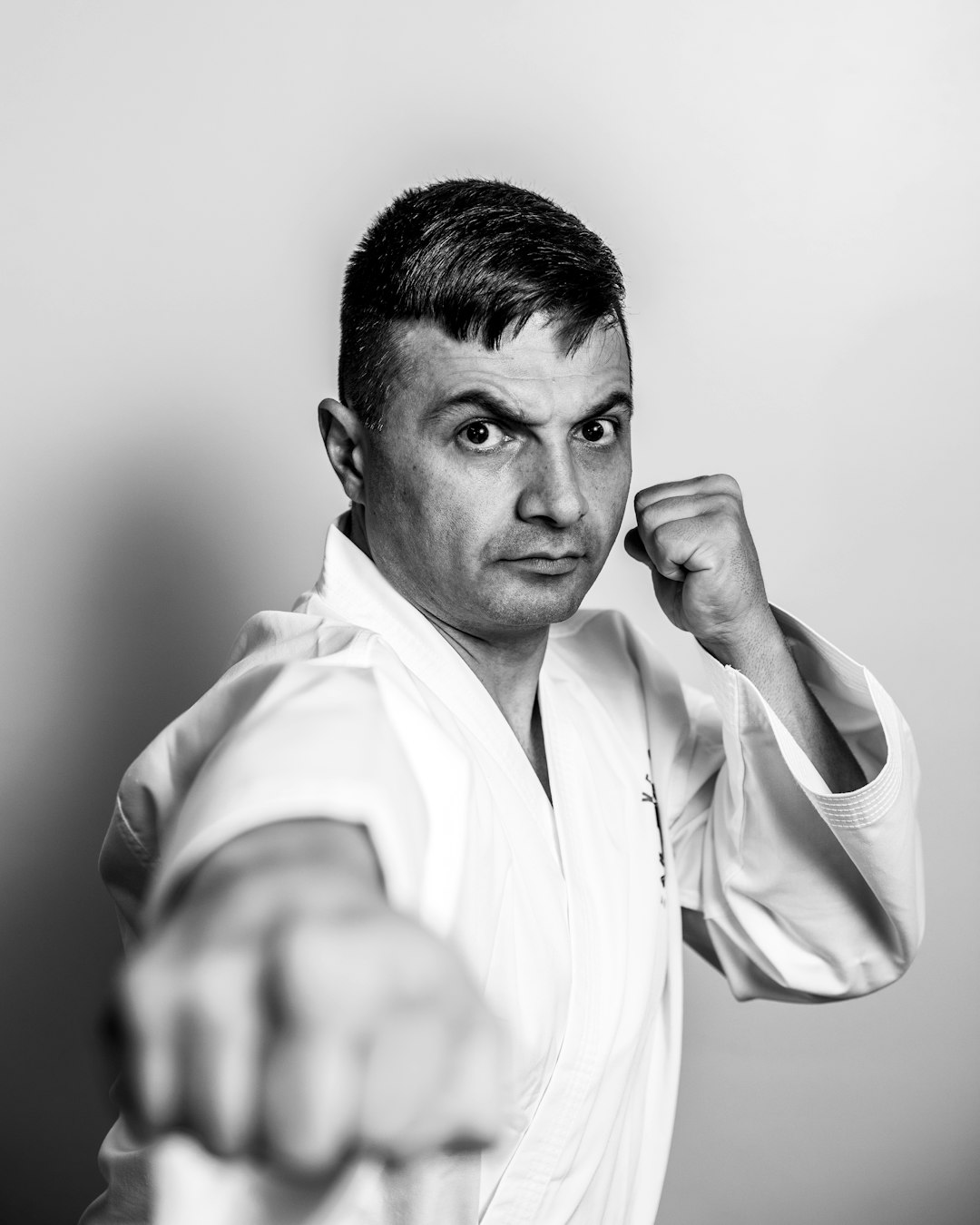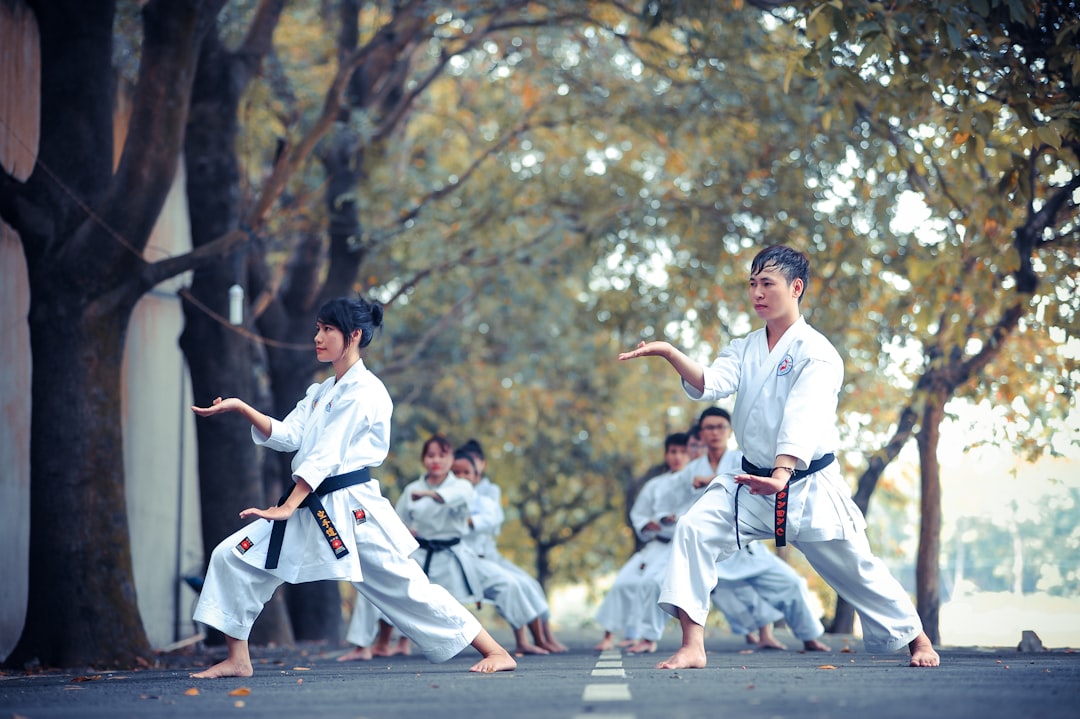When purchasing a karate gi, it's crucial to select one that is both comfortable and well-fitted for unimpeded movement and optimal training performance. Opt for a high-quality gi made from durable, lightweight materials like cotton or a blend that offers the right balance of flexibility and resilience. The jacket, known as 'ujira,' should have sufficient sleeve length and width to not restrict arm movements during kicks and blocks, while the 'rei-sayuki' trousers should be tailored to prevent tripping without hindering movement. Proper sizing is key; a gi that fits correctly will enhance your practice without hindering movement or circulation. For beginners, choose a size based on chest, waist, and height measurements, rather than solely on height and weight. Additionally, protective gear such as hand protectors, shin guards, headgear, groin guards, and mouthguards are essential for sparring, offering safety while adhering to the specific rules of your karate style or organization. When selecting a karate gi buy or protective equipment, focus on items that meet both functional needs and adhere to traditional karate standards for the best experience and safety. This ensures respect for karate's rich tradition while promoting effective performance and personal growth in the discipline.
Discover the myriad of essential equipment that forms the foundation of karate training. From selecting the ideal karate gi through to understanding the importance of protective gear, this comprehensive guide will illuminate the key items every practitioner needs for mastering the art. Whether you’re a beginner or an advanced martial artist looking to enhance your technique and safety, learn about the essential belt, mitts, and additional accessories that contribute to effective training in karate. Remember to consider the features and sizing of your karate gi when you buy one, as these factors are crucial for optimal performance and comfort during practice or competition.
- Essential Karate Gi: Features and Sizing for Effective Training
- Comprehensive Guide to Karate Protective Gear and Accessories
- Mastering the Art of Karate with Proper Equipment: Belt, Mitts, and More
Essential Karate Gi: Features and Sizing for Effective Training

When considering the purchase of a karate gi, it’s crucial to understand the features and proper sizing that make this traditional garment suitable for effective training. A high-quality karate gi should be made from a durable, lightweight cotton or a blend that allows for ease of movement while being resilient enough to withstand the rigors of practice. The jacket, known as the ‘ujira,’ should have long and wide sleeves to facilitate unhindered arm movements during techniques such as kicks and blocks. The trousers, called ‘rei-sayuki,’ must be tapered at the bottom to prevent tripping but not so tight as to restrict mobility. Proper sizing is key; a gi that is too large may hinder movement, while one that is too small can restrict blood flow and limit flexibility. Typically, the jacket should reach just above the belt tied around the waist, with the trousers hemmed at ankle length for optimal performance. When karate gi buy, always opt for a size that allows you to move freely without overfitting, ensuring that your training sessions are both comfortable and productive.
In terms of sizing, a beginner might wonder, “What height and weight should I be when choosing a karate gi?” The answer is that the gi should fit proportionally to your body. For instance, if you’re around 5’6″ and weigh approximately 140 pounds, aim for a medium size. However, individual measurements such as chest, waist, and height play a more significant role than just weight and height. The collar and sleeves should reach appropriately without being overly tight, allowing for a range of motion that is essential for the variety of strikes and blocks in karate. Remember, the goal is to find a gi that supports your movements without constraining them, ensuring you can practice with the best possible comfort and performance.
Comprehensive Guide to Karate Protective Gear and Accessories

When practicing karate, the right protective gear and accessories are crucial for safety, performance, and comfort. A karate practitioner must consider what equipment is necessary for their training, sparring, or competition. At the core of a karate practitioner’s attire is the karate gi – a traditional uniform that not only signifies respect for the martial art but also provides a canvas for belts to be tied, denoting rank and progression. When looking to buy a karate gi, it’s essential to find one made of durable cotton or a cotton blend that allows for ease of movement while withstanding the rigors of practice. Does the karate gi you’re considering offer this balance between comfort and durability? Ensure it does, as it will be your daily uniform during training sessions.
Beyond the gi, protective gear tailored to karate’s requirements becomes essential, especially during contact sparring or kumite. Hand protectors are a must to safeguard against injuries when practicing strikes, while shin guards protect the lower legs from impact during kicks. Headgear is also important to prevent head injuries, and groin guards offer protection for male practitioners. Mouthguards are non-negotiable to shield teeth and gums. When purchasing protective gear, seek out items designed specifically for karate to ensure they cater to the unique demands of this martial art. Are the protective gear options you’re considering designed with karate in mind? Remember to select equipment that aligns with the rules of your specific style or organization within karate, as requirements can vary.
Mastering the Art of Karate with Proper Equipment: Belt, Mitts, and More

When engaging in the discipline of karate, selecting the appropriate equipment is crucial for both performance and respect for the tradition. A fundamental piece of gear for any karateka is their gi, a traditional garment worn during practice and competition. The gi not only signifies the unity of mind, technique, and martial spirit but also serves as a canvas for belts that denote a practitioner’s progress and rank within the art. When karate gi buy decisions arise, it’s important to consider the material, fit, and durability, ensuring the garment is both comfortable and respectful to the practice. A well-fitted gi allows for full range of motion, which is essential for executing techniques with precision and control.
In addition to the gi, protective equipment such as mitts play a vital role in karate training. Mitts are designed to safeguard both the striker and the recipient of strikes, allowing practitioners to spar without causing undue harm. Choosing the right pair of mitts is equally significant; they must offer adequate protection while still permitting the user to feel their movements and sense the impact of their techniques. Mitts come in various levels of cushioning and coverage, so selecting the appropriate type based on the practitioner’s level and sparring intensity is key. Whether you’re a beginner looking for your first set of training mitts or an experienced karateka seeking high-performance gear, understanding the options available will enhance your practice and ensure a safe and effective training environment.
In conclusion, selecting the right equipment for practicing karate is paramount for both safety and effectiveness. A high-quality karate gi, tailored to fit properly, is an essential component for any practitioner. It not only facilitates freedom of movement but also fosters a sense of discipline and respect for the martial art. Complementing this with comprehensive protective gear and accessories ensures that karatekas can train confidently without undue risk of injury. Whether you’re aiming to buy a karate gi or procure additional training essentials, understanding the specifications and options available will significantly enhance your karate experience. With the right equipment, practitioners can fully immerse themselves in mastering this ancient and esteemed art.
